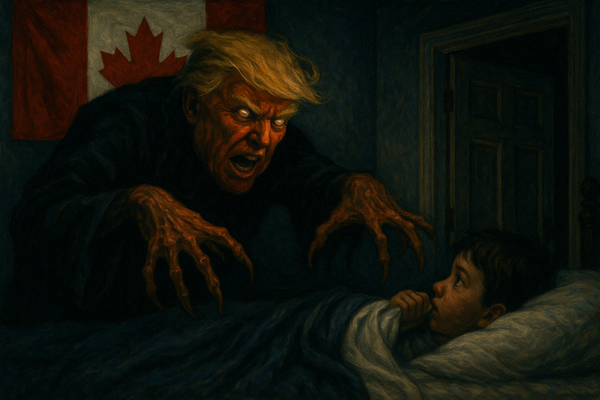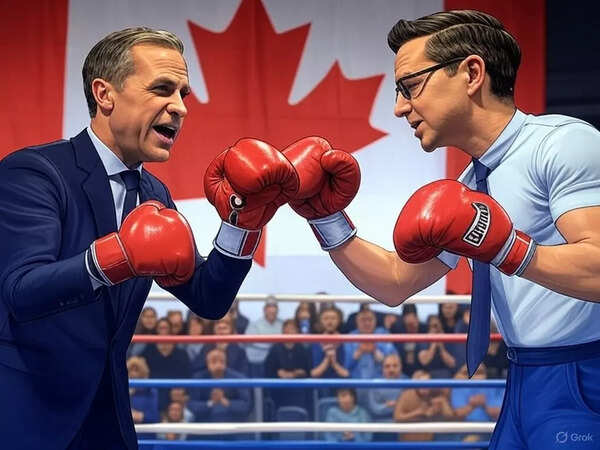Canada Election 2025: How to decide ‘Bogman’ Trump Election. world News

In a rapid polarly polarized Canadian election scenario, it is not a policy, but psychology that seems to shape voter behavior. A new National Post Pole released on 16 April depicts a striking emotional division: 75% of conservative voters say they are inspired by hope – for economic revival, low taxes and political changes – while 60% liberal supporters cite fear as their primary motivator, especially for Canada’s sovereignty and trade due to dangers of Donald Trump.
It is playing at the highest levels of fear-Banam-Hop Katha leadership, in which liberal leader Mark Carney has doubled the warning of the trump-rich North America, while the Orthodox Challenger Pierre Pilevere has picked up with renewal and national pride.
Carney fear Gambit: as Trump Bogman

Since leading the Liberal Party in March 2025, with 85.9% internal vote, Mark Carney has made one thing clear: the road to win in Canada can now be from Washington. His campaign speeches have been given serious warnings about Donald Trump’s second term agenda-which is to make rhetoric about converting Canada into a “51st state” from threats to tear USMCA.
In the provinces like Cubek, the fear message is affixed. Forty percent of Quebeccus voters cited fear as their primary emotional driver in this election, while compared to 40%. The difference, although narrow, reflects the intentional strategy of keeping himself in position as the final firewall between Canadian sovereignty and American encroachment.
Political analyst Leya Moro says, “Carney is considering this election as a referendum on Canada’s independence.” “By calling Trump, he is expecting to consolidate and consolidate the progressive vote in urban strongholds such as Montreal and Toronto.”
Nevertheless, critics argue that Carney’s campaign seems more like a crisis management seminar than a national vision. Despite taking the liberals up to 43% in the elections, their profit is diluted, with orthodoxies being shutting off the difference of 38% -A 1% from last week.
Poilievre’s hope aggressive: optimism strategy

In contrast, Pierre Poilavere can be the most emotionally excited campaign of Canada in a generation. His message? Reduced taxes, safe roads, and a government that “rely on Canadian people, it is more on them.” But above these, hope.
According to the National Post Poll, 75% of conservative voters recognize Asha as their main inspiration – a number that dwarfs anything seen in recent Canadian elections.
“Liberal party wants you to be afraid,” Pilevre told a mob in Von last week. “Fear of Trump, afraid of change, afraid of freedom. But I believe Canada can do better. I believe you can do better.”
His team’s message, especially Ontario, focus on the battlegins such as GTA, London and Hamilton, economic empowerment and optimism. The campaign scene includes smiling family, busy construction site, and Maple Leaf-Amblazond Dreams of Samriddhi.
It is working – at least for now. The steady growth of conservatives in elections is particularly pronounced among the suburban middle class voters, many of which feel squeezed by rising mortgage rates and stable wages. For them, the apocalypse of the carney can be out of the tone touch.
US Factor: Trump in rearview and windshield
Elephant – or rather, Eagle – Donald Trump remains in the room. His re -election in 2024 has put a long shade in Canadian politics. To suggest a “continental merger” from threatening anti -anti -tariffs to negligence, Trump offers a convenient villain to Carney and a complex challenge to Polylet.
In a political inverted of normal Canadian-American dynamic, it is the center-metal that is bending into nationalism, while the correct limit talks about cooperation.
With his background, as the Governor of Carney, the Governor of the Bank of Canada and the Governor of the Bank of England, there is no populist – but he is rapidly deploying nationalist trops to protect liberal democracy.
Meanwhile, Poilievre should walk on a criterion: Trump shows patriotism not protesting, whose unexpectedness can dismiss markets and derail any future conservative business strategy.
“This is a bizarre role inverted,” says Professor Althia Gaganon at the University of Toronto. “Liberals wave the flag and call for sovereignty, while conservatives pitch the economic practicality. This is 1984 – but upside down.”
What to see: The emotional center of Ontario
Quebec and Alberta were largely talked about, the emotional battleground lies in the Ontario. With a mixture of Greater Toronto region, immigrant communities, swing riding and economic concerns, possibly deciding.
Here, emotional partition national average: hope vs. fear, optimism versus anxiety. The question is, with which spirit people will get for votes?
So far, Carney’s fear appeal is gathering old voters and dying liberal supporters. But poelavere’s message is small, for the first time being surprisingly echoing among voters, especially people with debt and disillusionment.
Last Words: Fighting of Emotions, not facts
In the country known for moderation and policy debate, Canada’s 2025 election is taking shape as a referendum on the spirit. Carney is betting that the fear of the future of the trump-prose will take the liberals into the finish line. Poilievre is expecting optimism – and a touch of righteous anger – will bring their conservatives to power. As Canadians move towards elections later this year, one thing is clear: this election policy is less about platforms and what each side feel about the future is more about it. And in a political age rapidly operated by vibes, not vision, emotions can be the only currency that matters.




